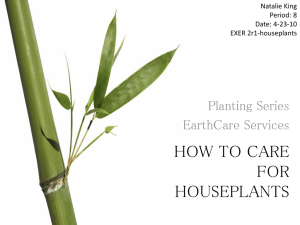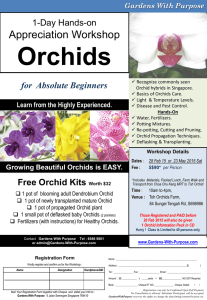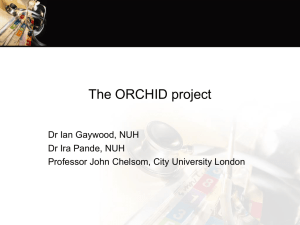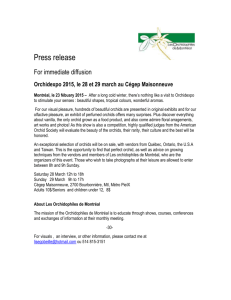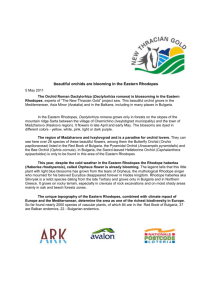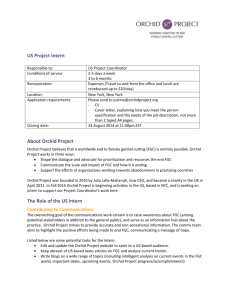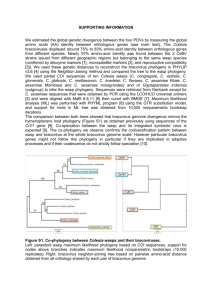Level 3 Biology (90716) 2010 Assessment Schedule
advertisement
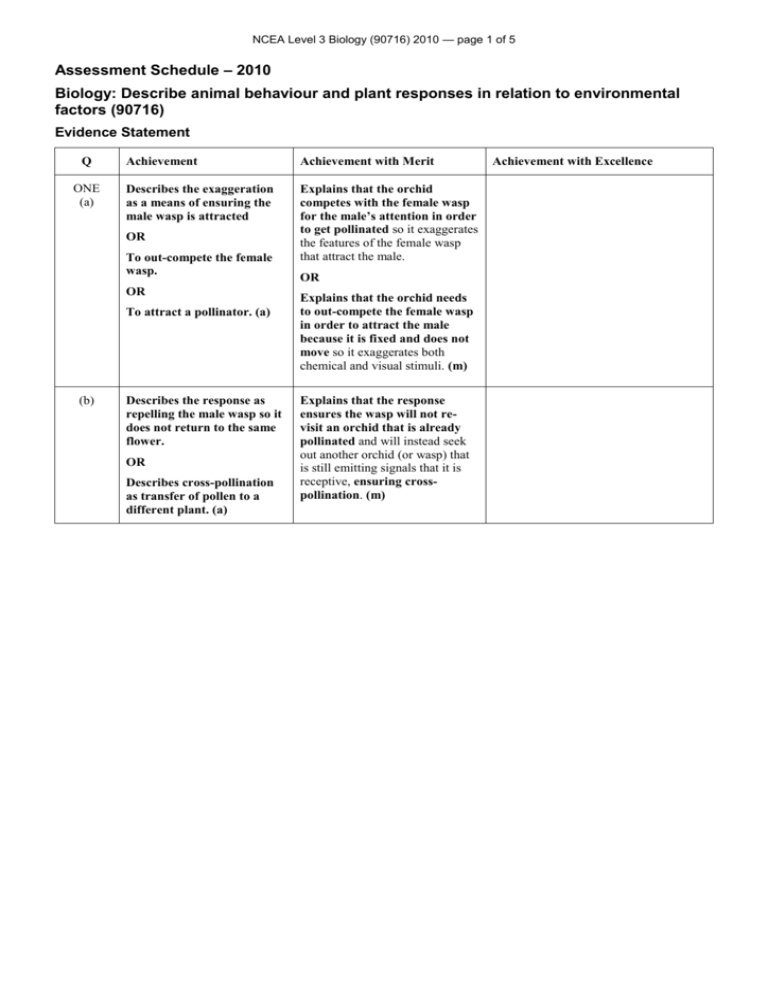
NCEA Level 3 Biology (90716) 2010 — page 1 of 5 Assessment Schedule – 2010 Biology: Describe animal behaviour and plant responses in relation to environmental factors (90716) Evidence Statement Q ONE (a) Achievement Achievement with Merit Describes the exaggeration as a means of ensuring the male wasp is attracted Explains that the orchid competes with the female wasp for the male’s attention in order to get pollinated so it exaggerates the features of the female wasp that attract the male. OR To out-compete the female wasp. OR To attract a pollinator. (a) (b) Describes the response as repelling the male wasp so it does not return to the same flower. OR Describes cross-pollination as transfer of pollen to a different plant. (a) OR Explains that the orchid needs to out-compete the female wasp in order to attract the male because it is fixed and does not move so it exaggerates both chemical and visual stimuli. (m) Explains that the response ensures the wasp will not revisit an orchid that is already pollinated and will instead seek out another orchid (or wasp) that is still emitting signals that it is receptive, ensuring crosspollination. (m) Achievement with Excellence NCEA Level 3 Biology (90716) 2010 — page 2 of 5 (c) Strategies used to maximise reproduction are identified (possible 2 a) The male thynnine wasp is exploited / deceived/ by the orchid into transferring pollen. OR Seed pods are packed full of seeds, which are small and light. OR The orchid seed forms a (symbiotic) relationship with the mycorrhiza. Either the relationship with the wasp OR the fungus is explained, including how and why the organism is used (possible 2 m) Eg Wasp: Eg the male thynnine wasp is exploited / deceived by the orchid. (Accept commensal relationship, as the wasp is not harmed / accept mutualism if thought wasp gains nectar.) AND The orchid produces exaggerated sex pheromones to chemically attract the wasp, then mimics the female wasp visually to deceive the male. The male pollinates the flower as it tries to mate with it. Once pollinated, the orchid changes its signal to that of a broody wasp so male wasps will not re-visit and waste pollen on a flower already pollinated. This ensures as many orchids are pollinated as possible and, means cross pollination occurs. (m) OR Eg Fungi: The orchid seed forms a (symbiotic / exploitative /accept commensal relationship, if thought fungi not harmed) relationship with the mycorrhiza. AND ONE OF: The orchid seed is purposely light so that it will travel far, but it has no food supply to enable germination. It must rely on the fungi mycorrhiza to germinate. The mycorrhiza provide the orchid seed with warm and moist conditions which ensure germination. Eventually the mycorrhiza might gain a food supply from the orchid once it has started to photosynthesise. The orchid produces many seeds to increase the chance that some may reach the fungus, therefore increasing the chance that more of the seeds will be germinated. (m) suff 3a=A 2m=M Discusses the relationships between the orchid and the wasp OR the orchid and the fungi AND Discusses how one strategy increases the orchid’s chances of reproductive success. (e) Eg Wasp: The orchid attracts a pollinator wasp by mimicking and exaggerating the sex characteristics of the female wasp. The wasp is used but is not harmed in the relationship. AND By exploiting the male wasp and using the same attractive pheromone as the female wasp, the orchid draws the male wasp to it in preference to the female wasp, instead of waiting for pollination to happen by chance. This increases the likelihood of pollination of the orchid. OR Eg Fungi: The orchid seed pod produces many seeds to increase the chances of at least a few germinating. The seeds are light, so they are easily carried by air currents to connect with mycorrhizal fungus. The orchid seed is so small that it will not have a food supply like a normal seed, so it forms a (symbiotic) relationship with the fungus to obtain food / energy / moisture in order to germinate. / The fungi may gain a food supply from the orchid once it germinates and photosynthesises. AND By producing many light seeds, the orchid increases its chances of reproductive success as there is a greater chance that some will find the fungus and therefore be more likely to germinate. 1e=E NCEA Level 3 Biology (90716) 2010 — page 3 of 5 TWO (a) The effect of changing from long day to short day is described for concentration or periodicity for LH OR FSH OR both (a) Eg the concentration of FSH increases as time from transfer to short days increases. No change in periodicity of LH cycle. LH cycle shows increase in concentration levels. FSH levels trend upwards over time. Both FSH levels and LH peaks are higher during short days. (b) An endogenous rhythm is described as an internal biological clock that is entrained by a zeitgeber. (a) OR The cause of changing levels in FSH and/ or LH is identified as change in photoperiod. (a) E.g. An endogenous rhythm is controlled by an internal biological clock that is reset by an environmental factor/day length/amount of light. Eg change in photoperiod / change in day-length triggers the rise in FSH levels and increase in peak size / surges in LH. Evidence from the graph is correctly quoted to support the changes described for LH OR FSH OR both (m) Eg FSH rises from max 20 ng cm–3 plasma at week 1 (end of long-day) to 260 ng cm–3 at week 5. LH cycle shows regular peaking from week 1 (end of long-day) through to week 6 (short day) of approx 3 per week, but peaks are much higher in short-day, between 9 and 11 ng cm–3 compared to 1 to 2 ng cm–3 at end of long-day. (Possible 3 m) The reason why the LH cycle is endogenous is explained. (m) OR Synchronisation of LH surges and / or rising FSH levels is explained as entrainment by photoperiod. (m) OR An advantage or a disadvantage of this type of rhythm for the ewes and their offspring is explained. (m) Eg the LH cycle is endogenous as the periodicity continues even when the light regime changes. Eg the free running LH rhythm is entrained / reset by the change in photoperiod. It remains constant, but surges in concentration show increase. Eg by going into oestrous in the Autumn when the photoperiod changes, a gestation period of 147 days will mean the lambs are born in spring when temperatures are warmer, but not too dry, so there should be plenty of food to produce milk to raise strong lambs. suff 2a=A 2m=M The nature of changing LH OR FSH hormone levels in sheep and how they are synchronised is discussed. The discussion includes advantage(s) or disadvantage(s) of this type of rhythm for ewes and their offspring. (e) Eg the LH cycle is endogenous as periodicity continues even when the light regime changes, peaking approximately 3 times per week. It is the level of concentration that increases, not the periodicity. Concentration of LH is entrained by photoperiod. OR Increase in FSH and LH concentrations are due to the change in photoperiod, which triggers or entrains the biological clock / detected by the pineal gland, triggering hormone changes that lead to ovulation. AND Ovulating in autumn and being pregnant through winter, ewes should give birth to lambs, when the climate is mild and moist so food supply for raising young is good, so lambs survive. / There is no guarantee the environment will be suitable for lambs, and changes in climatic conditions over time may lead to the cycle being a disadvantage instead. There is also increased competition between ewes and lambs, as many are born at the same time. 1e=E NCEA Level 3 Biology (90716) 2010 — page 4 of 5 THREE (a) (b) Describes the home range as the area where the troop finds food or as an occupied but undefended area. (a) Describes the impact of an environmental factor on home range size Explains the impact of an environmental factor on home range size OR daily range. (m) OR Eg home range size is smaller in habitats that receive greater rainfall, as there will be greater growth in these areas producing more food. Baboons can find their food from within a smaller area. Describes the impact of an environmental factor on daily range length. (a) Eg home range size is smaller where there is greater rainfall or home range size is smaller where there is some forest. OR Eg daily range length is greater in open grasslands, where it is drier. (c) Defines a dominance hierarchy as a group with an organised social structure controlled by dominant member (a) Identifies a benefit from being part of the troop, such as protection from predators/more food/reduced aggression (a) OR The drier open grasslands will have less available food supplies so the baboons will need to range longer distances daily in these areas to find enough food for the troop. Explains the concept of a complex dominance hierarchy (m) Eg an organised social group controlled by dominant (males), that works efficiently to protect and feed its members. AND Feature(s) of complex dominance hierarchy at least one of: subordinate groups bonding pairs family groups division of labour. AND / OR Explains a benefit from being a member of the troop. (m) Eg protection gained from being one of many in the group from predators. Dominant members are aggressive and scare away potential predators OR the group successfully locates food resources, due to many searching. Although the dominant members feed first, there is usually food for all. Suff 3a=A 2m=M Discusses the concept of a complex and highly organised dominance hierarchy,the benefits from being a member of the troop AND justifies why this increases the chance of survival of the individual. (e) The baboon hierarchy is a complex social organisation and not linear, as there are subordinate groups and affiliations within the overall group, such as mating pairs and families and associations are constantly changing. There is an alpha male in overall charge. AND Eg the group structure allows greater opportunity to locate food and greater survival chances for individual group members when conditions are difficult, or in the presence of predators./ Dominant males usually mate with the strong females to ensure genes are passed on and strong leadership continues, which ensures more “fit” individuals are produced and are therefore more likely to survive./ The group provides greater care for young through social bonding and increases chances of survival of the individuals into adulthood. 1e=E NCEA Level 3 Biology (90716) 2010 — page 5 of 5 Judgement Statement Achievement Achievement with Merit Achievement with Excellence 2 A 2M 2E
